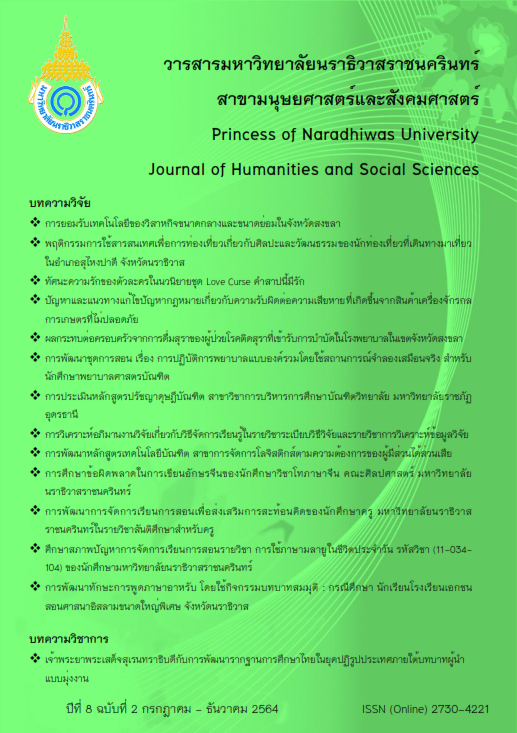Characters’ Conceptions of Love in Novel Series “Love Curse”, Kam Sab Nee Mee Ruk
Main Article Content
Abstract
This article aimed to analyze characters’ conceptions of love in the novel series of “Love Curse, Kam Sab Nee Mee Ruk”, which contains four episodes, written by four authors: “Kam Sab Ray Glay Ruk” by Pasrasaa, “Sab Ruk Ban Leng” by Panpreeya, “Thong Sab Ruk” by Jhaamuah, and “Pa Ti Han Ruk Thong Sab” by Suvila. Data were presented through an analytical description derived from literary criticism. Findings revealed that the authors portrayed three primary conceptions of love. First, the family love (parents and siblings) comprised two parent-related sub-conceptions as follows: (1) prioritizing their children’s happiness and giving them freedom to make their own decision to maximize their learning, (2) parents prioritizing their children’s happiness and always forgiving them when they make mistakes, and (3) siblings depending on each other and being together through thick and thin. Second, the romantic love contained four sub-conceptions including (1) sending best wishes and having dedication for love without expecting anything in return, (2) simplicity, lively, and fulfillment, (3) accepting the partner’s identities such as strengths and weaknesses, and remaining true to their emotions and (4) standing by one another, living in the present, and letting go of past mistakes causing from not accepting their own feelings Last, the superstitious love included four sub-conceptions, which were (1) letting go and forgiveness; leaving resentful and vengeful feelings, (2) not neglecting when others suffer, showing mercy to those in need, and lending help if affordable, (3) proving love through actions and time; and (4) accepting and trusting in true love, which leads to faith in love.
Article Details
References
เฉลิมศรี จอกทอง. (2534). แนวคิดเกี่ยวกับความรักในบทกวีนิพนธ์ของเอมิลี ดิกคินสัน. (วิทยานิพนธ์ปริญญาโท). มหาวิทยาลัยศรีนครินทรวิโรฒ, มหาสารคาม.
ฌามิวอาห์. (2555). ต้องสาปรัก. กรุงเทพฯ : บริษัท แจ่มใส พับลิซซิ่ง จำกัด.
ธัญญา สังขพันธานนธ์. (2539). วรรณกรรมวิจารณ์. กรุงเทพฯ: นาคร.
บุญยงค์ เกศเทศ. (2536). แลลอดวรรณกรรมไทย. กรุงเทพฯ : โอเดียนสโตร์.
ปัญญ์ปรียา. (2555). สาปรักบรรเลง. กรุงเทพฯ : บริษัท แจ่มใส พับลิซซิ่ง จำกัด.
ปาวีณ รัสมี. (2561). รูปแบบความรัก และภาษารักที่ปรากฏในมิวสิควิดีโอเพลงไทยลูกทุ่งสมัยนิยม. (วิทยานิพนธ์ปริญญามหาบัณฑิต). สถาบันบัณฑิตพัฒนบริหารศาสตร์, กรุงเทพฯ.
พนิดาพร จงราเชนทร์. (2559). รูปแบบความรักของนิสิตมหาวิทยาลัยศรีนครินทรวิโรฒ. วารสารวิชาการศิลปศาสตร์ประยุกต์, (กรกฎาคม-ธันวาคม), 29-37. ค้นจาก http://arts. kmutnb. ac.th/file_article/1501730222.pdf
พระครูสุนทรสังฆพินิต, ปกรณ์ มหากันธา, และสมหวัง แก้วสุฟอง. (2561). การศึกษาวิเคราะห์ ความรักในทัศนะอัลแบรต์ กามูส์. พุทธศาสตร์ศึกษา. 9(1), 42-56.
ภัสรสา. (2555). คำสาปร้ายกลายรัก. กรุงเทพฯ : บริษัท แจ่มใส พับลิซซิ่ง จำกัด.
โมนิล เตชะวชิรกุล. (2562). คุยเฟื่องเรื่องรักใคร่ ผ่านดวงตานักจิตวิทยา กับ ผศ.โมนิล เตชะวชิรกุล. ค้นจาก https://themomentum.co/love-psychology-monin/
ศุวิลา. (2555). ปาฏิหาริย์รักต้องสาป. กรุงเทพฯ : บริษัท แจ่มใส พับลิซซิ่ง จำกัด.
อารยา ทองเพชร. (2550). การวิเคราะห์แนวคิดและกลวิธีการนำเสนอแนวคิดในวรรณกรรมสำหรับเยาวชนของนงไฉน ปริญญาธวัช. (วิทยานิพนธ์ปริญญามหาบัณฑิต). มหาวิทยาลัยศรีนครินทรวิโรฒ, กรุงเทพฯ.


